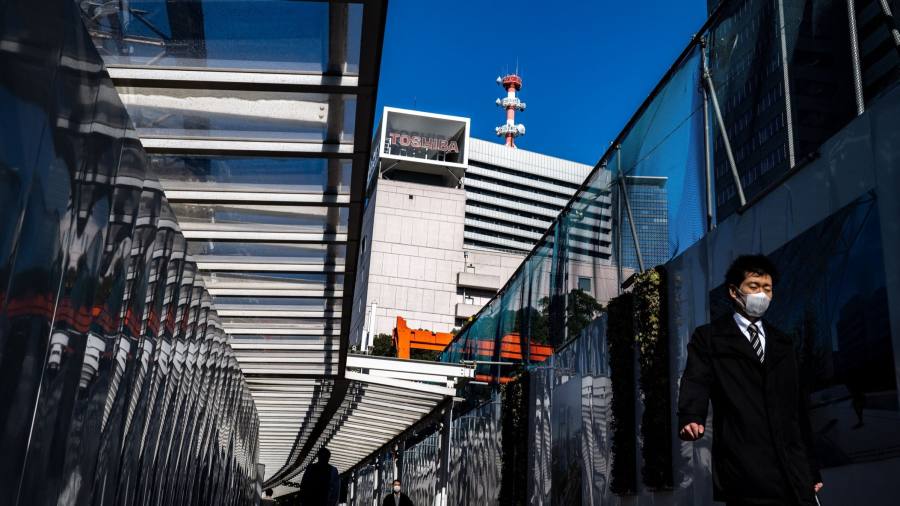Receive free Japanese business & finance updates
We’ll send you a myFT Daily Digest email rounding up the latest Japanese business & finance news every morning.
Sometime over the next few weeks, someone will bemoan the fact that foreign investors’ buying of Japanese stocks is not quite as vigorous as it was earlier in the year. Some may contend that the easy money has already been made. Some may even declare the “Japan is back” festivities over.
But Toshiba, poised for Japan’s biggest ever buyout and a landmark delisting after eight years of causing considerably more harm than good to Tokyo’s image as a financial market, may deliver a final, self-sacrificing leaving present.
Excitement around the Japanese market has indeed calmed after a frenetic few months, but not disastrously. From late March, enchanted by the prospect of accelerated corporate change, a permanently cheap yen and a broad investment rotation away from China, fund managers who had left Japan underweight in their portfolios for years were suddenly interested again.
Cumulatively, since late March, foreign investors have bought net $77bn worth of Japanese stocks and helped fuel the 20.6 per cent rise in the benchmark Topix index this year. They have not bought at that pace, or with that sustained level of conviction, since the early exuberant months of the “Abenomics” era a decade ago. In last week’s Bank of America survey of global fund managers, respondents said their allocation to Japan was its highest for nearly two years.
But the pace of foreign buying has slowed — as it always does — over the summer and, for technical reasons, is almost certain to reverse into a phase of acute net selling in September as hedge fund managers time an annual, tax-efficient divestment of holdings before the interim dividend period.
The buying always bounces back just as sharply not long afterwards, as the fundies repurchase the shares from the agent holding them, but there is a yearly stint where the market narrative switches to gloomy mode and the challenge for brokers is always to fire things back up from that.
This year, given how well the Japanese market has performed to date, the stakes in that effort will be higher. Brokers are already fretting that to keep the momentum alive beyond September, they will need to point to some convincing catalysts that will keep the market revaluation on track. China’s economic woes, Japan’s export troubles and other factors mean there are fewer obvious ones in easy reach.
Enter, rather unexpectedly, Toshiba: the troubled industrial conglomerate whose miseries have descended in a joy-drenching drizzle since 2015 and include an accounting scandal, a teeter on the edge of bankruptcy and the most acrimonious battle with shareholders in Japanese history. The company’s chair recently described this ordeal as an “eight-year tunnel”, but at least the exit is in sight. A consortium, led by the fund Japan Industrial Partners and backed by Japan’s largest banks, has made an approved Y2tn ($14bn) tender offer for the company, and there is very little at this point to suggest it will not succeed.
That is because a decent proportion of the shareholders are itching to sell. One of Toshiba’s biggest problems (beyond restructuring its business) has been that, in the depths of its financial crisis in late 2017, it got Goldman Sachs to place Y600bn new shares with investors. The emphasis was on speed and Goldman’s solution was to sell the placement to foreign hedge funds — and bring a series of notorious activists on to Toshiba’s once-sedate shareholder register.
In the ensuing years these funds, which still include Effissimo, Farallon, 3D and Elliott, have pushed Toshiba hard, forcing it to act in the interests of shareholders and cattle-prodding it towards a buyout. That process, and the arrival of the JIP bid, took far longer than anyone had bargained for but it became the only viable exit for the larger holders, so they have had to be patient. The original placement in 2017 put a Y2,682 price tag on the shares; JIP’s offer puts them at Y4,620. The funds have made money, but nothing like the steal they hoped for.
Now, the sudden arrival of $14bn in the hands of Japan-focused investors presents intriguing possibilities for the market: hedge-fund and activist money that has basically been locked up for six years can finally be redeployed into a Tokyo market where activism more consistently delivers returns than it did in 2017.
The largest five activists on Toshiba’s register, brokers estimate, hold about 25 per cent of the company’s shares between them, or roughly $3.5bn. Not all of that will automatically be redeployed in Japan, of course, but a very significant proportion may well find its way on to the register of dozens of other Japanese companies where the activists can see a path to more rapid returns. All the largest activists in Toshiba have dedicated Japan teams, and have made it clear they still see it as a market with a lot of opportunity.
But even outside the activists, the unleashing of a large slab of yen from Toshiba into the hands of its many current investors could provide a strong buying catalyst into the final months of the year. Toshiba may be off but Japan, at least, may be back for a little longer.
Read the full article here



